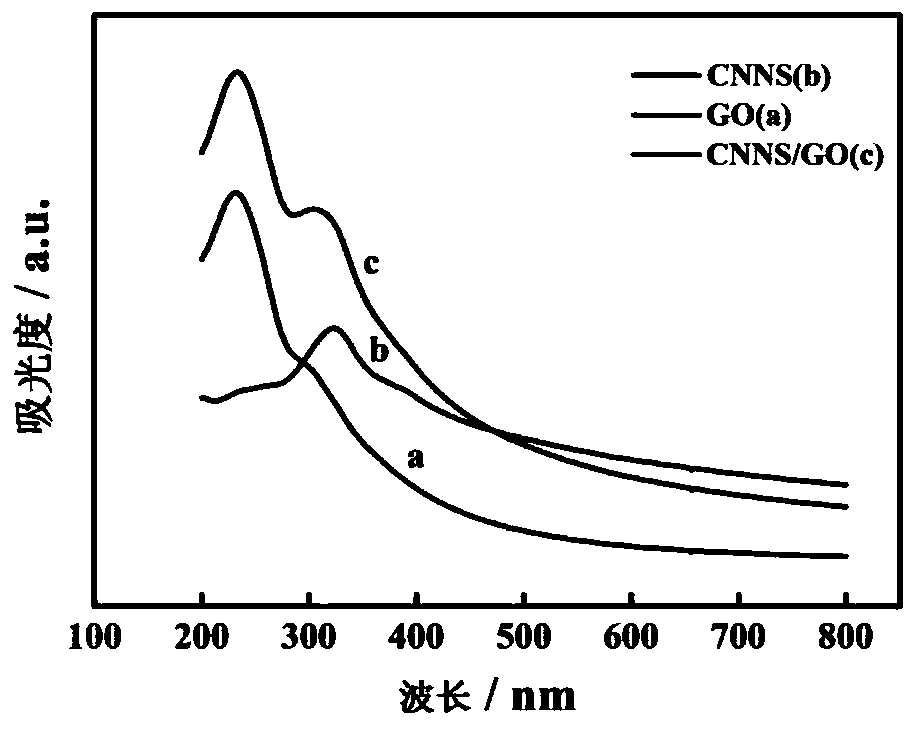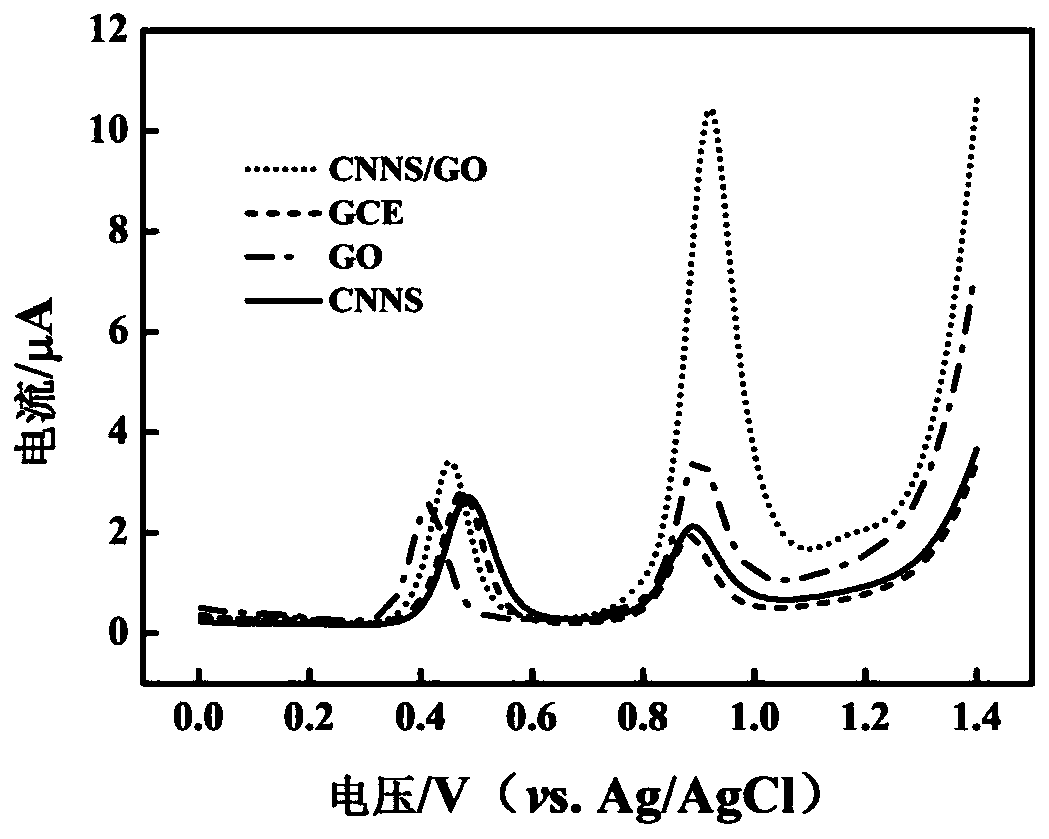g-C3N4 nanosheet/graphene oxide composite material and preparation method and application thereof
A technology of nano-sheets and composite materials, applied in chemical instruments and methods, analytical materials, nitrogen compounds, etc., can solve the problems of high cost, complicated detection technology operation, time-consuming, etc., and achieve convenient operation, good anti-interference ability, and simple method Effect
- Summary
- Abstract
- Description
- Claims
- Application Information
AI Technical Summary
Problems solved by technology
Method used
Image
Examples
Embodiment 1
[0034] A preparation method of CNNS / GO nano composite material, comprising the following steps:
[0035] 1) g-C 3 N 4 Preparation of Nanosheets (CNNS):
[0036] g-C 3 N 4 The preparation of nanosheets (CNNS) is divided into two steps. In the first step, Bulk-g-C was first synthesized by pyrolysis 3 N 4 , in short, put 5g of melamine in a corundum crucible and place it in a muffle furnace at 550°C with a heating rate of 2°C min -1 Heating in atmospheric environment for 2h. The resulting product was ground into powder and then further heated at 540 °C for 4 h. In the second step, CNNS was synthesized by ultrasound-assisted method. The yellow powder was dispersed in distilled water, followed by continuous sonication for 16 hours. The initially formed white suspension was then centrifuged at 4500 rpm to remove residual unstripped g-C 3 N 4 CNNS suspensions were obtained and used for further studies.
[0037] 2) Preparation of graphene oxide (GO) dispersion:
[0038] Gra...
Embodiment 2
[0044] One with g-C 3 N 4 The method for simultaneously detecting acetaminophen and levofloxacin by nano flakes / graphene oxide composite material comprises the following steps:
[0045] (1) The bare GCE surface was polished with 0.05 μm alumina particles, and carefully rinsed with ultrapure water and ethanol until a mirror surface was obtained and dried. Pipette 8 μL of CNNS / GO (1 mg / mL) prepared in Example 1 ) composite material was drip-coated on the surface of glassy carbon electrode (GCE), and fully dried under infrared light to obtain CNNS / GO modified electrode (CNNS / GO / GCE). As controls, CNNS / GCE, GO / GCE were prepared using the same method.
[0046] (2) Immerse GCE, CNNS / GCE, GO / GCE and CNNS / GO / GCE in the mixed solution of PBS (pH 5) containing AC (50 μM) and LEV (25 μM) respectively, and record the difference by differential pulse voltammetry. The oxidation peak current corresponding to the electrode. Such as image 3 As shown, there are two obvious oxidation peaks...
Embodiment 3
[0051] The present invention uses the electrode modified by the prepared CNNS / GO composite material to test the AC and LEV in the water sample of Fenhe River.
[0052] In order to evaluate the practicability of this sensor in actual sample analysis, water from the Fen River in Shanxi was selected for analysis to study the AC and LEV levels in the samples. The electrochemical response of DPV was recorded after adding quantitative amounts of AC and LEV to river water in the linear concentration range. First, the sewage sample is filtered through ordinary filter paper to remove suspended particles and other solid impurities. The filtrate is filtered through a 0.22 μm filter membrane and diluted 100 times. Add 0.8+1, 5+3, 28+10mol L -1 Three different concentrations of AC+LEV standard solutions were used for standard recovery determination, such as Figure 6 As shown in the DPV diagram, the sensor can realize the analysis of real samples.
PUM
 Login to View More
Login to View More Abstract
Description
Claims
Application Information
 Login to View More
Login to View More - R&D
- Intellectual Property
- Life Sciences
- Materials
- Tech Scout
- Unparalleled Data Quality
- Higher Quality Content
- 60% Fewer Hallucinations
Browse by: Latest US Patents, China's latest patents, Technical Efficacy Thesaurus, Application Domain, Technology Topic, Popular Technical Reports.
© 2025 PatSnap. All rights reserved.Legal|Privacy policy|Modern Slavery Act Transparency Statement|Sitemap|About US| Contact US: help@patsnap.com



